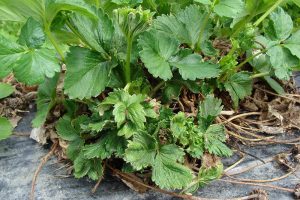Strawberry IPM Newsletter No. 1 – May 7, 2020
Strawberry IPM Newsletter No. 1 – May 7, 2020
Click on photos to enlarge.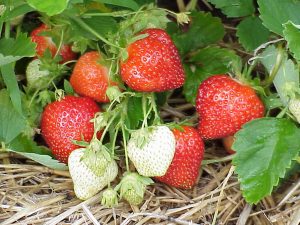
2020 STRAWBERRY PEST MANAGEMENT SEASON BEGINS
COVID-19 Pandemic and Restrictions Concern Pick-Your-Own Berry Markets
Twilight Meeting via Zoom on Tuesday, May 12 at 5:30 p.m.
Situation:
Lots of rain and wind, not much sun and cool temperatures have characterized this spring. This follows a winter that, although mild by some standards, arrived early with snow and cold temperatures, leaving some strawberry fields with no winter mulch or fall applied herbicides to control spring weeds. As a result, there is plenty of potential for winter injury to strawberry plants, for red stele root rot in fields with poor drainage, and early weed outbreaks. Plants are now starting to show a little growth, but I haven’t seen any flower buds on matted row beds yet. Growers using plasticulture and rowcovers may have flower buds already emerging or even starting to bloom. Freezing temperatures predicted for later in the week pose a high risk to both buds and flowers, and plasticulture growers should be prepared to frost-protect their plants.
We are all wondering how and if we are going to proceed with the harvest season under the constraints of the COVID-19 pandemic, and the Centers for Disease Control and Prevention (CDC) Guidelines, and governmental restrictions put in place to reduce its impacts. At this point, it looks as though we will be allowed to sell berries U-pick, but farmers and customers will be obligated to follow social distancing and sanitation protocols to prevent the spread of the virus to the best of their abilities. Working with State Departments of Agriculture, Extension Specialists at Cornell University, in cooperation with the other Northeast states have just finished a new guide “Best Management Practices for U-Pick Farms During the COVID-19 Pandemic.” This has been reviewed by the Maine Department of Agriculture, Forestry and Conservation, and approved for adoption by Maine Farmers, with an addendum of Maine-specific regulations and suggestions. Free downloads of the publications are available at Best Management Practices for Maine U-Pick Farms.
We will be holding a virtual twilight meeting via Zoom on Tuesday, May 12 at 5:30 p.m. to introduce and discuss the guide. Extension berry and food safety specialists, and members of DAFC, will participate to help address any questions you might have regarding the upcoming season. We will be sending out the Zoom link to the meeting shortly.
I have begun scouting strawberry fields for overwintering insect pests, disease issues and winter injury last week. Under our present COVID-19 guidelines, the number of sites I can visit are restricted, so I will be collecting data and making observations, which will be limited to just a few per week. I would be happy to add any pest situation developing in your fields to the Newsletter in order to keep your fellow growers informed. The results of my strawberry scouting will be reported through this newsletter until harvest time. You can also get quick access to this information through the UMaine Highmoor Farm News Blog or the UMaine Pest Management web page. If you have questions about the Newsletter, please give us a call at 933.2100 or send an e-mail message to Caitlin Ramsay at caitlin.ramsay@maine.edu.
Winter injury:
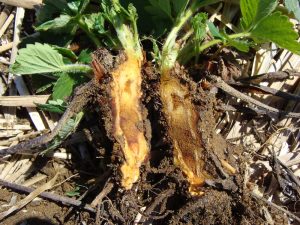
Plants may be victims of winter injury if they appear weak or dead, especially in more exposed parts of a field, where mulch was not applied or where mulch was displaced by wind or animals. This is caused by freezing of the tissue in the crown of the plants, and therefore can be diagnosed by cutting into the crowns of the strawberry plants. The internal tissue will show dark brown discoloration. To reduce the impact of winter injury, make sure the plants get plenty of water, and apply nutrients to encourage root growth and flower development, which should include: nitrogen, calcium, and phosphorus. Heavy nitrogen fertilizer applications in the spring are not recommended, but up to 20 pounds of actual N (e.g. 125 lb. calcium nitrate) may improve early spring growth. I have also seen some deer damage to overwintering crowns, and received reports of vole damage from other northeast states.
Spring Weed Management:
Some growers were not able to make their typical dormant fall herbicide applications due to the early snowfall. Herbicides available for spring applications are much more limited due to concerns about plant injury and harvest intervals. Dacthal® and Devrinol® herbicides are registered for use in the spring and can be very effective on annual grasses and some broadleaf weeds, but only have pre-emergent activity, i.e. will not control weeds already emerged. Other herbicides have some post emergent activity but may only be applied with a shielded sprayer to the areas between the plant rows, not directly over the plants, or injury is likely to occur. These materials include Chateau®, Prowl H2O®, Satellite Hydrocap®, and Aim®.
Red Stele Root Rot
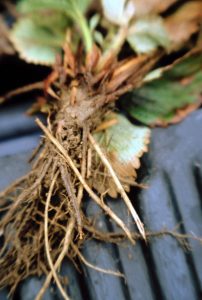
Spring conditions have been very conducive to red stele development, so you should be alert for this root rot and check any fields that appear to be weak, stunted or dying. To diagnose red stele, pull up a few plants that look weak and scrape the roots of these plants to see if the center of the root, known as the stele, is rusty red in color, instead of the normal white. The red color would indicate an infection. Red stele is caused by Phytophthora fragariae, a soil pathogen that infects roots when soils are wet with temperatures around 50°F. The pathogen grows into the roots causing the plants to become weak, stunted and will eventually die. Symptoms are most evident in the spring, and can be mistaken for winter injury. Ridomil Gold®, Alliette® or Phostrol® are fungicides that can be applied in the late fall or early spring for control of red stele. Spring applications in fields that have any history of red stele are recommended this year, due to the extended period of potential infection. In newly planted beds, RootShield® may be applied as a pre-plant root dip to help prevent infections. Many varieties have some level of resistance to this disease, but the most effective management strategy is to plant only into well-drained soils, and/or plant onto raised beds.
Two-spotted spider mites can be a problem in the spring, especially for plants under row covers. I observed high populations of two-spotted spider mites on overwintering plants earlier this spring, so I expect this pest will be a concern for growers as temperatures rise. Mites reproduce rapidly when warm weather arrives, so it is important to scout for them regularly. Spider mites mostly feed on the undersides of strawberry leaves by rasping the plant tissue and sucking the sap. Infested leaves will develop yellow flecking and a bronzed appearance. The plants become weakened and stunted. Fields that have had excessive nitrogen fertilizer and/or row covers tend to be most susceptible to mite injury. To scout for mites, collect 60 leaves from various locations in the field and examine the undersides for the presence of mites. Mites are very small; you may need a hand lens to see them. Chemical control options for two-spotted spider mites include Acramite®, Portal®, Nealta® Savey®, Zeal®, Vendex®, Oberon®, Brigade®, Danitol® and JMS Stylet Oil® (oils will cause plant injury if used in combination with captan or within 14 days of an application of sulfur).
Cyclamen mites:
We have also had reports of cyclamen mites being active on strawberry plants growing under rowcovers this spring. Plants showing weak growth and yellow, pinkish or blackened, crinkled leaves may be infested. These mites are very small, smaller than spider mites, and reside in the crown of the strawberry plant feeding on the developing leaves and flower buds. They are very hard to see, even with magnification. Infested plants have: shrunken distorted leaves and flower stalks, and produce few to no marketable fruit. The miticide Portal® can be effective, but must be applied in lots of water and a spreader adjuvant to be sure that the material is carried down into the crowns where these mites reside.
- Cyclamen Mite Damage on Strawberry Plant; photo by David Handley.
- Two-spotted Spider Mites; photo by David Handley.
Root weevil management
Fields that were infested with root weevils last summer should be inspected for grubs this spring. Infested plants appear weak and stunted, usually in somewhat circular patches in a field. Digging under the plants will reveal small (1/4”-1/2”) crescent-shaped legless grubs. Typically, the grubs begin to pupate when the plants are in bloom. A soil drench of Platinum® (thiamethoxam) insecticide during the spring and/or fall when the grubs are active in the soil can provide control. However, Platinum® has a 50 day pre-harvest interval, so it is too late for applications in most fruiting fields this year. Platinum® may also be used as a pre-plant or planting treatment for root weevils. It is not too late to put on an application of nematodes to control the grubs (optimal timing is mid-late May). Two species of nematodes appear to offer the best control of root weevil grubs. Heterorhabditis bacteriophora (Hb) appears to be the best candidate for control of root weevils when the soil temperature is above 60 degrees, and is available from Green Methods, the Integrated Biocontrol Network, and Koppert Biological Systems.
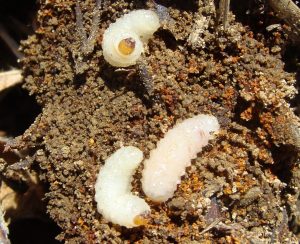
Order nematodes ahead of time and be ready to apply them through a sprayer or irrigation soon after they arrive. Do not apply nematodes using a sprayer with a piston pump. Use clean equipment, removing all screens finer than 50-mesh. Apply nematodes in the early morning or in the evening in a high volume of water to already moist soil, pre-irrigate if needed. Apply another 1/4 inch of irrigation after application to wash them onto and into the soil. Researchers and suppliers recommended 250 (if banded in the row) to 500 million per acre, at a cost of $100-$200 per acre depending on volume and source. Nematodes tend to work best in heavily infested fields. Strawberry plants can recover their vigor remarkably well if crown feeding has not occurred and diseases haven’t taken over the roots.
Once the adults become active in July, bifenthrin (Brigade®) will provide some control if used at the highest labeled rates. The best timing for this spray is at night during the peak feeding activity of adults, before they start laying eggs, or about the time harvest ends.
White grubs:

Weak growth noted in fields this spring may also be the result of white grubs feeding on the roots of newer plantings. These grubs are the larvae of beetles, including European chafer and Asiatic garden beetle. They differ from the larvae of black vine weevil and strawberry root weevil in that they have legs and a swollen anterior (rear end), and they tend to be larger. Their feeding weakens the plants by reducing the number of roots. The grubs can be found by pulling up weak plants and sifting through the soil that surrounded the roots. Controlling white grubs once they have become established in a field can be difficult. These tend to be more of a problem in new fields that have been planted following a grass rotation crop, because the adults prefer to lay their eggs in sod. Admire Pro® and Platinum® insecticides are labeled for control of white grubs and should be applied within two hours of irrigation or rainfall to be sure the chemical gets into the root zone. Admire Pro® requires a 14 day to harvest interval, while Platinum® requires a 50-day pre-harvest interval.
Diseases:

Once flower buds start to open, bloom is a critical time to protect strawberry fruit against gray mold
caused by the fungus Botrytis cinerea, especially when conditions have been damp. Two to three sprays of fungicide during bloom are typically required to provide good protection against this disease. Botrytis cinerea overwinters on old leaves and plant debris. Fruit infections take place almost exclusively through the flowers, so gray mold control efforts must be focused on the bloom period. If the bloom period is dry and/or good fungicide coverage is maintained, incidence of gray mold at harvest should be low.
There are several excellent fungicide choices for control of gray mold in strawberries. Elevate® (fenhexamid) has good to excellent activity against Botrytis. Captevate® is a pre-mix of captan and fenhexamid and has a broader spectrum of activity than Elevate® alone. Switch® (cyprodinil and fludioxonil), Scala® (pyramethanil) and Pristine® (pyraclostrobin and boscalid) are also excellent products for gray mold control. Topsin M® + captan is also a good fungicide combination, but remember that captan is strictly a protectant and can be washed off by rain or irrigation water. Thiram is similarly effective, but also susceptible to wash-off.
The fungicides Cabrio® (pyraclostrobin) and Abound® (azoxystrobin) are NOT suitable for gray mold control, but are effective against anthracnose and other fruit rot and leaf spot diseases. All fungicides mentioned above have a 0-day pre-harvest interval, except Topsin M® (1 day) and thiram (3 days). Remember to alternate fungicides with different modes of action for resistance management purposes.
Angular leaf spot is a bacterial disease that is characterized by translucent leaf spots that may turn yellow and eventually black. The symptoms tend to start on the lower leaves but may move upwards as bacterial spores are splashed up by rain or irrigation water. Infection of the calyxes may result in a blackening of the berry stems and caps, reducing their marketability. Bacterial angular leaf spot is favored by extended cool, wet weather and nights with temperatures close to freezing. Frequent irrigation for frost protection can greatly encourage the development and spread of the disease, as will extended cool, damp weather. Susceptibility to this disease appears to vary significantly between varieties. The copper-containing material Kocide®, can reduce the spread of this disease. Start spray applications before bloom to prevent multiplication of the bacteria on the leaves before they jump to the berry caps. Application of copper sprays after bloom can result in fruit injury and is not recommended. Hydrogen dioxide (OxiDate®) may also have some activity against angular leaf spot when used on strawberries as part of a gray mold management program.
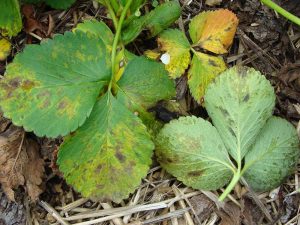
Other Berries:
Raspberries are showing significant winter injury in many fields, with tip dieback showing as the buds begin to expand. Further injury may become apparent once the floricanes start to flower and emerged lateral branches wilt and die due to damaged vascular tissue.
Highbush blueberries are showing some winter injury on last year’s growth. This appears as a dark brown or black discoloration on the shoots. The damage is usually limited to growth above the snowline. The cool, wet weather has initiated the release of mummy berry spores from the overwintering mummies. Expect infection periods to continue over the next few weeks, anytime there is a significant moisture event (rain, mist, fog). Protectant fungicides for mummy berry should be applied once the flower buds have begun to expand. Registered materials include Indar®, Orbit®, and Quilt Excel®.
Strawberry Disease Management Study & Survey: We are excited to inform you that the Northeast Sustainable Agriculture Research and Education (SARE) organization, approved our research and education proposal to address two major limiting factors in strawberry production through research and outreach. This is a multi-state collaboration including Maine, West Virginia and Virginia. Research objectives are listed below, and demonstrations will take place on grower cooperators farms where other growers can come and see the results of the research and determine possible adoption of the technology. In addition, winter educational workshops will be conducted as another chance to learn about the results of the research. We hope you will take the time to participate in this 4 question survey to let us know of your interest in this work. The objectives of the proposed work are below.
Objective 1: Assist two major plant propagators in the region to prevent latently infected plants entering the production field through providing enhanced diagnostic support.
Objective 2: Demonstrate the efficacy of non-chemical fumigation methods (mustard cover crop and anaerobic soil disinfestation) or the use of beneficial microbes to minimize black root rot and other soil borne diseases, such as crown rot to improve yield on farms.
Dr. Alicyn Smart, Plant Pathologist, University of Maine
Dr. Mahfuz Rahman, Associate Professor and Plant Pathology Extension Specialist, West Virginia University
Dr. Jayesh Samtani, Assistant Professor and Small Fruit Extension Specialist, Virginia Tech
Project title: Optimization of preventative biorational strawberry fruit and root disease management techniques: linking university research to growers education
2019-2020 New England Small Fruit Management Guides are available from UMaine Cooperative Extension. The guide contains the latest information on management options for small fruit pests as well as cultural information. You can also access the guide online at UMass Cooperative Extension Website
The best way to manage strawberry pests is to scout your own fields regularly and often. You should begin to scout as soon as flower buds emerge from the crowns and continue to monitor the plantings one or two times per week up until harvest. You should be able to identify the major pests and their damage, and be able to determine if control measures are necessary.
Sincerely,
David T. Handley
Vegetable and Small Fruit Specialist
Highmoor Farm Pest Management Unit
P.O. Box 179 17 Godfrey Dr.
Monmouth, ME 04259 Orono, ME 04473
207.933.2100 1.800.287.0279
Where brand names or company names are used, it is for the reader’s information. No endorsement is implied nor is any discrimination intended against products with similar ingredients. Always consult product labels for rates, application instructions and safety precautions. Users of these producers assume all associated risks.
The University of Maine is an equal opportunity/affirmative action institution.

